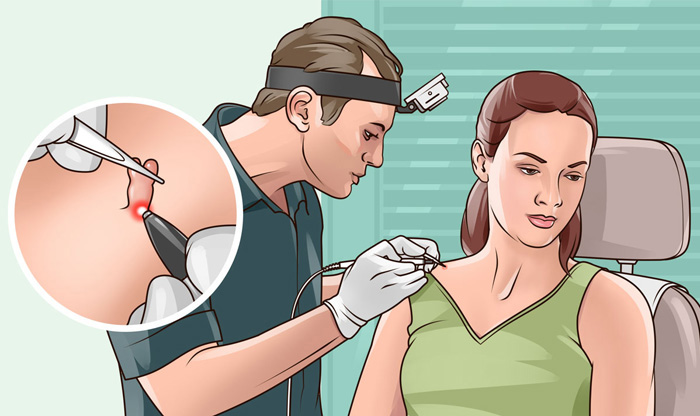Many people confuse skin tags with cancerous growths and feel panic when seeing them. In reality, skin tags have nothing to do with cancer and they’re absolutely painless.
Being attached to the skin by a peduncle, which looks like a small, thin stalk, skin tags can pop up anywhere on the body. Both women and men can have skin tags – especially those who are in their 50s. Read on to learn more about skin tags and how you can treat them.
What are skin tags?
A skin tag, also known as an acrochordon or soft fibroma, is a tiny part of hanging skin, which has either a stalk or a peduncle. A skin tag usually appears where the skin rubs against clothing or other skin.
Join Agogo Newsletter
And get Updates for Better Health.
A skin tag isn’t life-threatening, but you can get rid of it for a cosmetic or aesthetic reason. The skin tag surface can be irregular or smooth in appearance. It can be a bit brownish yet treatable.
Skin tags may appear on the neck, upper chest, groin, under the breasts, armpits, eyelids, and other parts of the body. Unless skin tags are located in a prominent area or they’re repeatedly scratched or rubbed, they might be unnoticed.
Many people who have skin tags might not even notice them. Sometimes, skin tags painlessly fall off or rub off without any treatment. Big skin tags can cause discomfort and burst under slight pressure.
What are the causes and risk factors?
There’s no scientific evidence about the causes of developing skin tags. However, researchers suggest that skin tags might occur when clusters of blood vessels and collagen get trapped in the thicker skin area.
Since skin tags tend to appear in skin folds or creases, skin rubbing against the skin might be the leading cause of skin tags.
The hereditary factor plays its role, too. There are people who are prone to skin tags due to hereditary factor.
Overall, men and women alike can have skin tags, albeit women have a higher risk factor. Obese and overweight people and those diagnosed with diabetes are at risk, as well.
Pregnant women are more likely to have skin tags because of weight gain, pregnancy hormones, and other growth factors. Sometimes, a few skin tags on one or different body areas can be a warning signal of an endocrine problem or a hormone imbalance.
Skin tags have been linked to hyperinsulinemia, which is often mistaken for hyperglycemia or diabetes. When there’s an elevated level of insulin in the blood, there’s a likelihood for skin tags to appear.
The great news about skin tags is that they’re not contagious. Due to a genetic connection though, it’s typical for several family members to develop skin tags.
According to scientific review, people who suffer from high blood pressure or hypertension, have high cholesterol levels, and are obese have a high risk factor for developing skin tags. The increased high-sensitive C-reactive protein can also contribute to skin tag development.
People with certain kinds of human papilloma virus and those who have changes in progesterone and estrogen levels have a high risk of developing skin tags. Scientists suppose that skin tags might be an indicator of cardiovascular disease, atherosclerosis, metabolic syndrome, and diabetes.
How to spot a skin tag
One of the best ways to spot a skin tag is by looking at the peduncle. There are different types of skin growths and moles, but unlike them, a skin tag hangs off the skin by the peduncle.
The majority of skin tags are hard to spot as they’re tinier than 0.07 inches or 2 millimeters. Some skin tags can grow bigger and become more than an inch or several centimeters.
Skin tags are usually flesh-colored and soft when you touch them. Skin tags might be asymmetrical and wrinkly or round and smooth.
One skin tag might look like a grain of wheat or rice while another one can resemble a thread.
Moreover, because of hyperpigmentation, a skin tag might look a bit darker than the skin around it. In case a skin tag gets twisted, it’ll look blackish because of poor blood flow. Some skin tags cause discomfort or mild pain, so you can easily spot them.
How to treat skin tags
Skin tags aren’t dangerous, but if you have one on your face or in any visible area of the skin or if it causes discomfort or pain, you might want to get rid of it.
In many cases, skin tags require no special treatment as they rub off on their own. If you have a big skin tag firmly attached to your skin, surgical treatment will help you to remove it for good.
Avoid removing skin tags at home as there’s a huge risk of bleeding, infections, and even blood poisoning. You can find many hacks on how to remove skin tags at home with the help of a thin cotton thread or dental floss, but these hacks can be dangerous.
Talk to your doctor to find out how to remove your skin tag safely.
In general, there are four ways that doctors use to eliminate skin tags.
The ligation procedure involves using a surgical thread to remove a skin tag. The thread will help to cut off the skin tag’s blood flow, preventing it from growing.
The electrosurgery procedure involves using high-frequency electrical energy to safely burn off a skin tag. The surgical removal involves using a scalpel or scissors to get rid of a skin tag.
Cryotherapy or cold therapy is probably the most common skin tag removal method used these days. It involves using liquid nitrogen to freeze a skin tag.
Each skin tag removal method has its benefits and risks, so only a medical expert can decide on which method to choose.
If you have a skin tag on your eyelid or too close to your eyelid margin, you’ll need to see an ophthalmologist to remove that skin tag. As this is a sensitive area, there’s a big risk of causing damage to the eye.
If your skin tag is tiny and doesn’t cause any discomfort or pain, your doctor can recommend you to use over-the-counter solutions to remove your skin tag. You can purchase those solutions at pharmacies. These solutions work by freezing a skin tag and helping it to fall off painlessly in 7 to 10 days.
If your skin tag is small, chances are you might be shaving or waxing it without noticing it. It can start bleeding and stop after 15-20 minutes. If you accidentally shave off a skin tag and bleeding doesn’t stop, see your doctor immediately.
Can skin tag removal result in more skin tags?
It hasn’t scientifically been proven that skin tag removal can stimulate the growth of more skin tags. Many people believe that a skin tag is like acne, but in reality, there’s little to no chances that a skin tag can spread if you remove it.
Some people – especially pregnant women – just have a higher risk of developing more skin tags regardless of whether they remove the existing tags or leave them. It depends on the root cause of your skin tag.
Is biopsy required after skin tag removal?
Unless your skin tag is huge and dark-colored, there’s no necessity in sending it for biopsy. However, certain skin bumps, particularly those that have rapidly changed or bled might need microscopic examination. Weird skin growths that resemble skin tags might be examined as well. Although a skin tag has nothing to do with a tumor, it’s still better to check it out. It’s very rare that a skin tag becomes cancerous or precancerous. Skin tags that grow, bleed, cause pain, or turn different colors, including black, red, brown, or pink require a pathologic examination to ensure it’s not skin cancer.
How to prevent skin tags
Skin tags are almost impossible to prevent. They appear imperceptibly and can disappear the same way. Surgical removal can’t prevent the growth of new skin tags.
Skin tags aren’t a serious condition, yet they can cause discomfort and even pain if you leave them untreated. Since prevention isn’t an option here, you can learn how to spot skin tags and be sure to consult a doctor.
Remember, only a medical expert can determine skin tag removal method. Avoid any homemade treatments and over-the-counter solutions if you have a big skin tag. Not only are they ineffective, but they can result in dangerous side effects.













